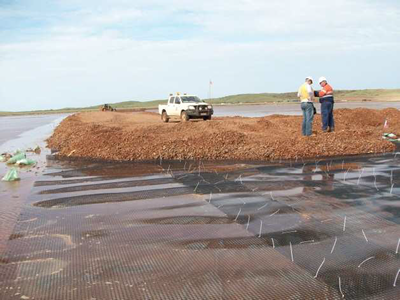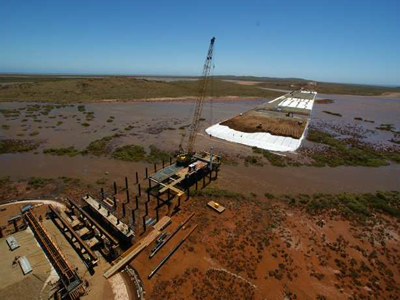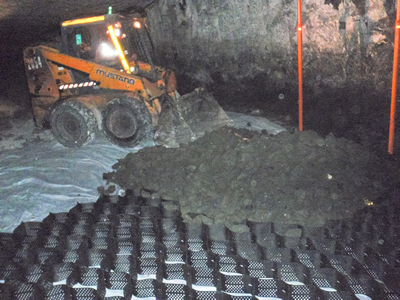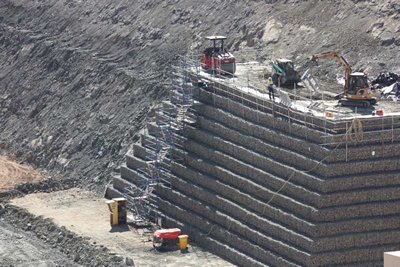 When GeoAfrica 2013 convenes in Accra, Ghana 18-20 November 2013, Prof. Malek Bouazza (Monash University) will deliver one of the keynote addresses on a subject dear to Ghana’s continuing development: mining. Prof. Bouazza will focus on the many ways geosynthetics have, can and should be utilized in mining. Here, we publish a two-part summary of “Geosynthetics in Mining Applications” from the keynote paper authored by Prof. Bouazza, Will Gates (SmecTech, Monash University) and John Scheirs (ExcelPlas). The full paper and presentation will be available at GeoAfrica 2013. SEE ALSO: Part 1 on Containment. – Chris Kelsey, Editor, Geosynthetica
When GeoAfrica 2013 convenes in Accra, Ghana 18-20 November 2013, Prof. Malek Bouazza (Monash University) will deliver one of the keynote addresses on a subject dear to Ghana’s continuing development: mining. Prof. Bouazza will focus on the many ways geosynthetics have, can and should be utilized in mining. Here, we publish a two-part summary of “Geosynthetics in Mining Applications” from the keynote paper authored by Prof. Bouazza, Will Gates (SmecTech, Monash University) and John Scheirs (ExcelPlas). The full paper and presentation will be available at GeoAfrica 2013. SEE ALSO: Part 1 on Containment. – Chris Kelsey, Editor, Geosynthetica
**
BASAL REINFORCEMENT

The fact that mine operations are located in most cases in remote sites where access can be problematic due to the topography of the terrain and the geology of the region combined with the excessive loads imposed by machinery and heavy duty mining trucks can have a dramatic effect on their viability if cost effective engineered solutions are not proposed for the design and construction of all the needed infrastructures. Geosynthetic inclusions within a soil mass can provide a reinforcement function by developing tensile forces which contribute to the stability of the geosynthetic-soil composite material (i.e. reinforced soil structure). Soil reinforcement is now a highly attractive alternative for infrastructure projects because of the economic benefits it offers in relation to conventional constructions processes structures. More importantly it can offer quicker, flexible, and environmentally accepted solutions to build infrastructures such as loading and access platforms, roads, embankments and retaining walls.
Basal reinforcement of embankment sited on soft soils is an effective and well-established form of reinforced soil construction. The use of geosynthetics such geotextiles or geogrids can improve the embankment stability, allows a more controlled construction process and more uniform deformation or settlement of the embankment. This approach has been used to address a challenging stability problem at the Sino Iron project (Swifte 2013). The Sino Iron project is a world class, large-scale magnetite iron ore project located at Cape Preston, in Western Australia’s Pilbara region. It is the largest planned magnetite project in Australia with an estimated 2 billion tonnes of identified magnetite ore.

Swifte (2013) indicated that a crucial component of the overall project was the construction of a 30 km long services corridor connecting the port to the mine site. This services corridor had to be completed in advance to enable the transportation of all heavy equipment for the mine site. Part of this services corridor consisted of a 2 km long causeway constructed through a river estuary and sitting on very soft soils characterised by very low undrained strength. The causeway embankment ranged in height from 1 m to 7 m, with a crest width of 32 m and had to be designed to allow for heavy vehicle loadings from 240 tonne haul trucks as well as the safe transport of 1400 tonne giant grinding mills for the mining operations. The solution adopted to allow the embankment to be constructed and enhance its stability was to place a nonwoven geotextile and a geogrid at the interface between the embankment sub-base and the soft soil subgrade and 0.6 m of crushed rock on top of the geogrid to provide a working platform. This was followed by the placement of three layers of high strength woven geotextiles across the base of the causeway embankment. The first fill lift was placed on top of the geotextile reinforcement, spread out and compacted to construct an initial fill platform of 0.5 m thickness. On top of this fill platform the second geotextile reinforcement layer was placed and then a 0.3 m thick fill layer placed on top. Finally, the third geotextile layer was placed and then the embankment was constructed to its completed grade alignment.
GEOCELLS IN UNDERGROUND MINES

The behaviour of roadways within soft strata in underground coal mines can cause problems when trying to attain minimum height to the roof but having to dig the road down into the base and expose underlying soils with low bearing capacities. Furthermore, soft rocks in underground mines are usually argillaceous and thus prone to deterioration when in contact with water. In these situations, the roadways can become impassable when mine vehicles, shuttle cars and mining machines create ruts when deepen over time and require maintenance to continue access (Swifte 2013). The presence of water only worsens the situation, making the maintenance of these roads costly and causing expensive delays to mining operations. Solutions, such as concrete and cement stabilisation, are expensive and create problems when materials need to be transported underground.
Using a combination of nonwoven geotextile and geocell confinement system can provide the necessary stability for roadways rather than relying solely on loose ballast (Swifte 2013). In this case, the nonwoven geotextile acts as a separation layer that prevents the soft clays pumping up into the ballast pavement. The geocell constrains the aggregate from moving laterally, which increases the shear strength of the soil and prevents wheel–path rutting. Geogrids are sometimes used to further reduce differential settlements. A number of coal mines in New South Wales and Queensland, Australia, have adopted this solution to extend significantly the life of their underground pavements.
REINFORCED SOIL BUTTRESSES

Garrard et al. (2012) presented an interesting approach used to stabilise a steep, blast damaged mine slope face at Cape Preston in Western Australia. A great deal of blasting has been done at the site to create a stock pile of ore and to shape the site into a working mine. Crusher slots were created to house the crusher plant. The site shaping allowed mine haul trucks to dump ore into the top of the crushers with conveyors transporting the primary processed ore from the base of the crushers.
In blasting for the crusher slots and ROM pad, the rock face between 2 crusher slots was over blasted and was assessed as unstable. This unstable face needed to be stabilised, a reinforced soil wall option was selected as representing the most cost effective and practical solution.
The wall loadings were unusually high as they were being generated from the movement of 600 Tonnes mine trucks. The project combined the use of geogrids and steel wire reinforcement behind a rock filled gabion basket facing to build the 21 m high retaining wall structure wall.
ACKNOWLEDGEMENTS
Some of the information contained in the authors’ full paper is based on a keynote lecture prepared in collaboration with Prof. A. Fourie (UWA, Australia), Dr. J. Lupo (Newmont, USA) for the 9th International Geosynthetics Conference (May 2010). Their contribution is gratefully acknowledged. Case studies on reinforcement applications in mining projects have been kindly provided by Geofabrics Australasia Pty. Ltd., the authors are grateful to their help.
For full references and the 31-page paper, see the GeoAfrica 2013 proceedings.
A. Bouazza (malek.bouazza@monash.edu) and W.P. Gates (will.gates@monash.edu) are with the Dept.of Civil Engineering, Monash University, Australia.
J. Scheirs (john@excelplas.com) works for ExcelPlas Pty. Ltd., Melbourne, Australia.











